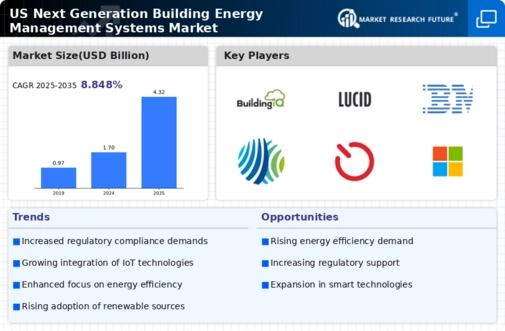Rising Energy Costs
The escalating costs of energy in the US are driving the next generation-building-energy-management-systems market. As energy prices continue to rise, businesses and homeowners are increasingly seeking solutions to optimize energy consumption and reduce expenses. The US Energy Information Administration reported that energy prices have increased by approximately 15% over the past five years. This trend compels organizations to invest in advanced energy management systems that can provide real-time monitoring and analytics. By implementing these systems, users can identify inefficiencies and implement corrective measures, ultimately leading to significant cost savings. The demand for energy-efficient solutions is expected to grow, further propelling the next generation-building-energy-management-systems market as stakeholders prioritize financial sustainability alongside environmental responsibility.
Technological Advancements
Rapid advancements in technology are reshaping the next generation-building-energy-management-systems market. Innovations such as artificial intelligence, machine learning, and the Internet of Things (IoT) are enhancing the capabilities of energy management systems. These technologies enable more precise monitoring, predictive analytics, and automated control of energy usage. For example, AI-driven systems can analyze historical data to forecast energy demand, allowing for more efficient energy distribution. The integration of IoT devices facilitates real-time data collection and analysis, which is crucial for optimizing energy consumption. As these technologies continue to evolve, they are expected to drive the adoption of next generation-building-energy-management-systems, making them more accessible and effective for a wider range of users.
Increased Focus on Sustainability
The growing emphasis on sustainability is a key driver for the next generation-building-energy-management-systems market. Organizations across various sectors are increasingly prioritizing sustainable practices to meet consumer expectations and corporate social responsibility goals. This shift is evident in the rising number of companies committing to carbon neutrality and reducing their environmental footprint. According to a recent survey, over 70% of US businesses have implemented sustainability initiatives, which often include the adoption of energy management systems. These systems not only help in tracking energy usage but also in identifying opportunities for renewable energy integration. As sustainability becomes a core business strategy, the demand for next generation-building-energy-management-systems is likely to surge.
Government Incentives and Regulations
Government initiatives aimed at promoting energy efficiency are significantly influencing the next generation-building-energy-management-systems market. Various federal and state programs offer financial incentives for adopting energy-efficient technologies, which encourages businesses to invest in advanced energy management systems. For instance, the Energy Policy Act provides tax deductions for energy-efficient commercial buildings, which can amount to $1.80 per square foot. Additionally, regulations mandating energy efficiency standards are becoming more stringent, compelling organizations to comply with these requirements. As a result, the next generation-building-energy-management-systems market is likely to experience growth as companies seek to align with regulatory frameworks while capitalizing on available incentives.
Growing Awareness of Energy Efficiency
There is a notable increase in awareness regarding energy efficiency among consumers and businesses, which is positively impacting the next generation-building-energy-management-systems market. Educational campaigns and resources provided by government agencies and non-profit organizations have contributed to this heightened awareness. As a result, more stakeholders are recognizing the benefits of energy management systems in reducing energy waste and lowering operational costs. A recent report indicated that organizations implementing energy-efficient practices can save up to 30% on energy costs. This growing consciousness is driving demand for advanced energy management solutions, as users seek to enhance their energy efficiency and contribute to broader environmental goals.

















Leave a Comment